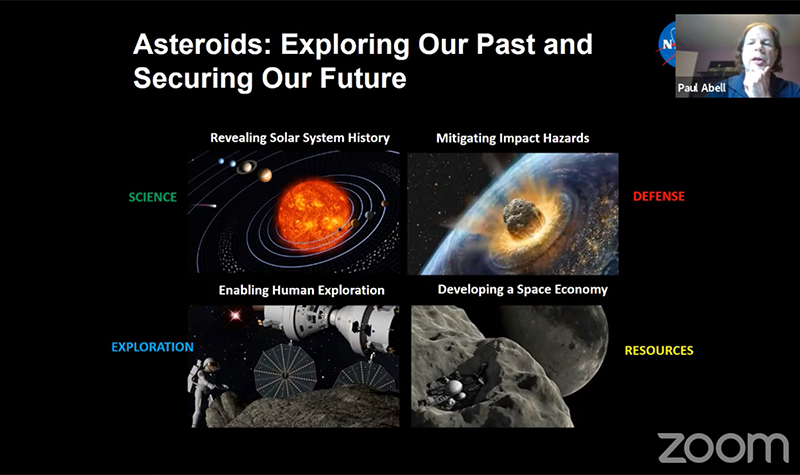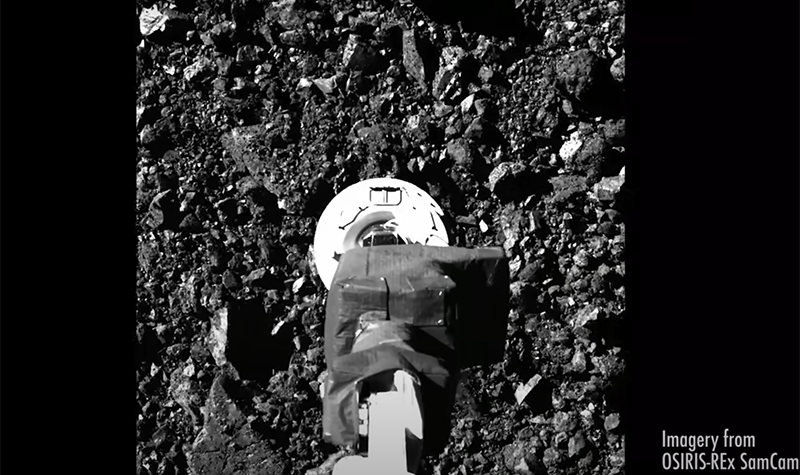Fly me to the near-earth objects
NASA Chief Scientist and UND graduate Paul Abell looks at asteroids as ‘stepping stones’ to reaching Mars and beyond

Most people know how to navigate to a travel site and book a plane ticket for their next vacation. But how many know how to book a trip to an asteroid?
Paul Abell, a 1993 graduate of UND’s Space Studies program, is one.
As Chief Scientist for Small Body Exploration in the Astromaterials Research and Exploration Science Division at NASA’s Johnson Space Center in Houston, Texas, Abell is an expert on the comets and asteroids residing in our solar system.
In particular, Abell specializes in studying the millions of comets and (mostly) asteroids that can be found between the Sun and the main asteroid belt between Jupiter and Mars. These celestial bodies are classified as “near-earth objects” if their orbit passes within 1.3 Astronomical Units of the Sun, meaning within 1.3 times the distance between Earth and the Sun.

For more than a decade, Abell has taken part in some of the world’s most advanced efforts to understand these remnants of the solar system’s creation, including a collaboration with the Japanese Aerospace Exploration Agency (JAXA) through the Hayabusa and Hayabusa2 projects, as well as NASA’s ongoing OSIRIS-REx mission. These missions represent the first set of efforts to collect samples directly from the surfaces of near-earth asteroids (NEAs).
Abell was on the team in 2010 that collected the first-ever direct samples dropped to Earth by the Hayabusa probe, in Australia.
Presenting an overview of his work at the Department of Space Studies Colloquium Series on Monday, Abell talked about future phases of NEA exploration – including manned missions to the surfaces of asteroids.
In his words, space rocks of all sizes and shapes are literally the stepping stones for missions exploring distant planets, including future trips to Mars.
“We’re going back to the Moon, and that’s relatively close. But going to Mars is a really hard and long-duration mission,” Abell remarked. “In looking at nearby asteroids, we can execute missions that will take less than a year.
“There are lots of reasons and benefits for considering NEAs for potential missions.”
Through relatively short-term missions to NEAs, NASA and similar agencies can gain vital operational experience in developing deep-space systems. There are also implications for scientific discovery, resource use and planetary defense when it comes to visiting small bodies wholly different from other worlds we’ve encountered. Along the way, international, commercial and academic partnerships stand to benefit from NEA exploration both manned and unmanned, Abell said.
Said Professor Pablo De Leon, chair of the UND Department of Space Studies and host of the Colloquium Series: “A question that I get a lot is, ‘What can I do once I graduate?’ The answer, ‘You can be a NASA Chief Scientist like Paul Abell,’ is not a bad one!”

Booking a trip to the solar system
True, it’s too early to find any listings on Expedia for your next trip to an asteroid. But there is in fact a website that has made it possible for people with the prerequisite knowledge to plan a rendezvous. Abell spent a portion of his talk describing how it works.
The trip planner, so to speak, is the result of NASA’s Near-Earth Object Human Space Flight Accessible Targets Study (NHATS). As the name of the long-term study infers, NASA has been tracking the thousands upon thousands of objects that are viable for interaction, given Earth’s own orbit and the velocities necessary for a safe meetup and return.
Those thousands are only a fraction of the millions of objects – ranging from a few meters to hundreds of meters in diameter, located from the inner solar system to the main asteroid belt beyond Mars’ orbit – that have so far been discovered, independently of known planets and moons.

Going through some examples of the website in his PowerPoint presentation, Abell walked through the factors that scientists are looking at in terms of mission viability. The table shows an object’s estimated diameter in meters, its absolute magnitude (luminosity), the number of possible trajectories by which to reach it and even a range of mission durations depending on the launch date and approach velocity, among other factors. Regularly updated, the site provides results for mission windows through 2045.
“NHATS also gives you an orbit condition code, which signifies how well the object has been observed on a scale from zero to nine,” Abell said. “The lower the number, the more those orbits are known and reliably calculated.”
If there’s further interest in booking an itinerary, it’s possible to click on the name of the object to get a more detailed and color-coded view of opportunities available. Abell mentioned that he and his colleagues regularly publish updates in a newsletter style that indicates the objects to which NASA is paying attention.
“Typically we’re looking at NEAs that have a number of trajectories well over 100,000 and a size above 50 meters,” he said. “That’s about the lowest diameter that we consider.”

To explore the past and secure the future
A student question following Abell’s NHATS tutorial evoked more of why his work is of importance to NASA and the future of space exploration: What would human missions to NEAs accomplish what robotics missions can’t?
In response, Abell pointed to the ongoing OSIRIS-REx mission and how it addresses the motivations behind NEA exploration – scientific discovery, resource use, development of operational capabilities and planetary defense.
“With that project gathering a sample from an asteroid, it’s covering a few of those bases,” Abell said. In other words, analyzing samples can tell us more about that particular body’s origins (science), its available resources (such as water or possible fuel sources) as well as its composition (in the event we have to mitigate its path to prevent a collision with Earth).
“At the same time, that robotic mission doesn’t address any of the human mission considerations,” he continued. “You can cover all of those aspects in a manned mission while at the same time testing the capabilities of the spacecraft without committing to a long-duration, complex mission.”
Basically, in getting out to explore the solar system, it’s best to fill the knowledge gaps in small chunks, as opposed to trying to do everything in one shot, Abell said. Using the stepping stones of Earth’s neighborhood, space agencies can progress from robotic surveillance, to human interaction, to habitation and so forth.
When thinking about Mars in particular, NASA needs opportunities to learn about the reliability and reparability of propulsion systems, developing high-capacity communications systems, radiation shielding and the effects of microgravity on humans, according to Abell.
“Near-earth asteroids are really important for exploring our past and securing our future,” Abell remarked.



